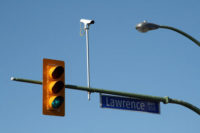Multi-Layer Defenses Protect Perimeters




On March 1 of this year, Kenneth Mazik barreled his SUV through a security fence at the Philadelphia Airport and drove onto the runway. Aircraft controllers were given only seconds to divert an incoming commercial jet before collision with the rogue vehicle. Fortunately, airport police and security were well prepared to deal with the incident; as Philadelphia Police Chief Inspector Joseph Sullivan reported on ABC News: “The ground radar kicked in; the tower was alerted immediately and they made sure to divert flights coming in and then quickly shut the airport down.”
In this case, while Mazik penetrated the perimeter security of the airport, the second layer of security potentially saved many lives.
Perimeter security is often a facility’s first defense against intruders, errant vehicles and terrorist threats. “Achieving security awareness depends on knowing the precise location and nature of an intrusion for early detection and fast response,” notes John Romanowich, president and CEO of SightLogix. “This is a global challenge for the transportation industry on the whole, where seconds can be the difference between safety and disruption.” Intelligent video from the company can detect the presence of unauthorized persons over large perimeters such as those at airports to provide early warning and actionable data as an event unfolds. This gives security teams time to respond before damage can occur with “eyes on until hands on” capability.
Beyond airports, military bases have the same stringent security requirements. For example, two military bases in Hawaii recently beefed up their defenses with a barricade system designed not only to stop intruders, but to trap them as well.
Schofield Barracks is the largest Army post in Hawaii, housing more than 14,000 soldiers, civilians, contractors and military families. Fort Shafter, also on Oahu, houses an additional 5,000 people and the base of U.S. Army, Pacific. These bases house the Tropic Lightning Division, the Command Headquarters for the U.S. Army Hawaii, and the command station for most Army forces in the Asia-Pacific region, excepting Korea. The East Range in Schofield Barracks also is the location for soldier system and chemical-biological defense testing.
With all of this going on, the typical method of controlling perimeter access (stopping each vehicle directly on the perimeter while keeping the gate closed) is impractical. Thousands of personnel and their families travel through the 11 entrances daily. Besides, the Army wanted to apprehend anyone who dared to attack the bases, especially vehicle-based bombers, not just stop them at the door.
So now, at all 11 entrances, the Army has a multi-step defense system. There is a screening area where a guard checks each vehicle for the appropriate identification. If a non-authorized vehicle ignores the guard or speeds off into the base, the vehicle access system is activated.
At the two main entrances to Schofield and Shafter, there is a two-part access system designed to trap any potential attacker. Should a vehicle drive past the guard at one of these entrances, one of Delta Scientific’s high-security barricades pop out of the road in only one second, stopping and destroying even a 65,000-pound dump truck traveling at 50 mph.
After that, the second barrier drops into action. The barricade is used at all 11 entrances, covering a 12- to 20-foot wide area. In case an errant vehicle were to attempt to gain entry at one of the lesser entrances, it would still have a difficult time getting past the vertical lift barricade, which can stop a 15,000-pound vehicle traveling 50 mph – dropping into position in 0.7 seconds.
If an attacker is caught between the barricades, or (more likely) is stuck in his or her vehicle after colliding with one, then the Army officials can surround and apprehend that person.
The barriers also maintain an aesthetically pleasing image, as the drop beam is always upright unless in use and the pop-up barricade folds flush to the roadway, with no buttresses, counterweights or road plates obstructing traffic. These help to promote an element of surprise as well as an unobtrusive view for residents.
And while Schofield and Shafter had a strong vision of what they wanted to accomplish with their perimeter security plans, there are many options for guarding a perimeter. According to Adam McGuern of Optex, Inc., when securing a perimeter, it’s important to consider:
- Stay current with the technology. Work with integrators who have been trained in the latest technology that they’re pitching, and look for partners who continue to work closely with their manufacturer, as they should have access to the most up-to-date techniques and designs.
- Understand what kind of protection you need and how the products work so you can plan out how to use the property in the future without obstructing detector paths or creating camera dead zones.
- Go wireless. There are many options for reliable wireless detection for outdoor perimeter applications, and, in many cases, these can utilize existing wireless infrastructure, which can eliminate labor and wiring costs, and often provide a much better-designed system.
- Invest in video monitoring. Using a video surveillance system to provide immediate verification can be extremely useful when sorting through alarm activations that leave no physical evidence behind. Those legitimate invasions might be labeled as “false alarms” by first responders without video evidence of what transpired. The majority of photobeam or PIR detectors can be set up to trigger a camera.
- Plan your detection coverage. Take careful stock of your perimeter’s weak areas, such as tight spaces between a fence and a wall where an intruder could jump over the gap. McGuern also recommends using redundant measures such as having integrators double-stack photoelectric beams to keep intruders from “jumping over or crawling under” detection.
- Coordinate with integrators and manufacturers to save on costs. Often, the manufacturer might find something on the design plan that the integrator missed that could save you money in the long run. Also, integrators who take advantage of manufacturers’ mounting hardware might get it for little or no additional cost, also reducing the cost and producing a unified, professional look to the system.
|
Combining Methods to Secure the Perimeter |
|
Tim Meyers had a tailgating problem. At Case New Holland manufacturing facilities around the country, access management was an increasingly impossible task as polite employees used keycard-operated doors, but allowed others to follow them into the facility without swiping their own access cards. “Our sites used to be wide open,” says Meyers, the North America Security Manager for Case New Holland, a company that builds heavy-duty construction and agricultural equipment. “We needed to gain an accountability of who all was on our site. We want to ensure we have a safe and secure work environment for our employees.” Meyers combined fencing and turnstiles to solve his tailgating and identified access management problems. Working with Boon Edam’s full-height turnstiles and its card-access control system, Meyers also integrated cameras into the equation. He implemented an identity verification system through surveillance cameras that works with video monitoring personnel to validate that visitors are who they say they are, especially during off-hours like nights and weekends. “If an employee forgets their keycard, they use the call box and give an employee identifier to the guard, who can validate that person’s identity with a photo ID system,” Meyers says. The identifiers vary by location and have included unique clock numbers and birth dates. “These combined solutions have really allowed us to get a handle on who comes in and out of our facilities,” Meyers says. “Especially from an emergency standpoint, I can give an accurate timeline of who was where and when.” |
Looking for a reprint of this article?
From high-res PDFs to custom plaques, order your copy today!









